Management Accounting: Systems, Techniques and Reporting
VerifiedAdded on 2020/12/29
|21
|5511
|494
Report
AI Summary
This report provides a comprehensive overview of management accounting, exploring its core principles and applications within business organizations. It delves into the significance of management accounting in aiding decision-making by providing accurate and timely data. The report examines various management accounting systems, including cost accounting and inventory management, and their roles in optimizing profitability and market share. It also discusses different reporting methods, such as budgets and performance reports, and the importance of these reports for internal stakeholders. Furthermore, the report analyzes several management accounting techniques, including marginal costing and absorption costing, highlighting their advantages and disadvantages in different scenarios. The annexures provide raw data and financial statements to support the analysis. Overall, the report demonstrates how management accounting systems and techniques help businesses manage costs, improve operational efficiency, and make informed strategic decisions.
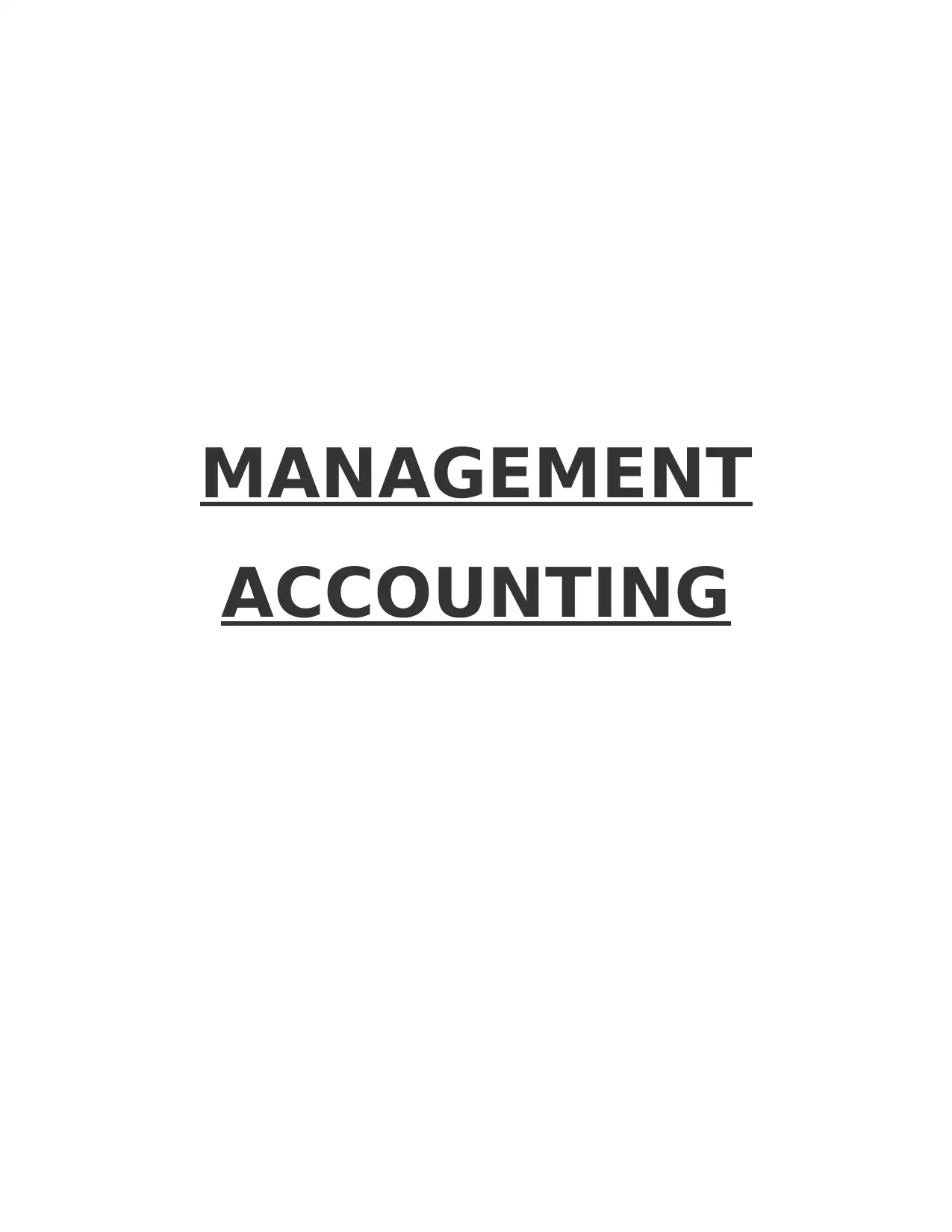
MANAGEMENT
ACCOUNTING
ACCOUNTING
Paraphrase This Document
Need a fresh take? Get an instant paraphrase of this document with our AI Paraphraser
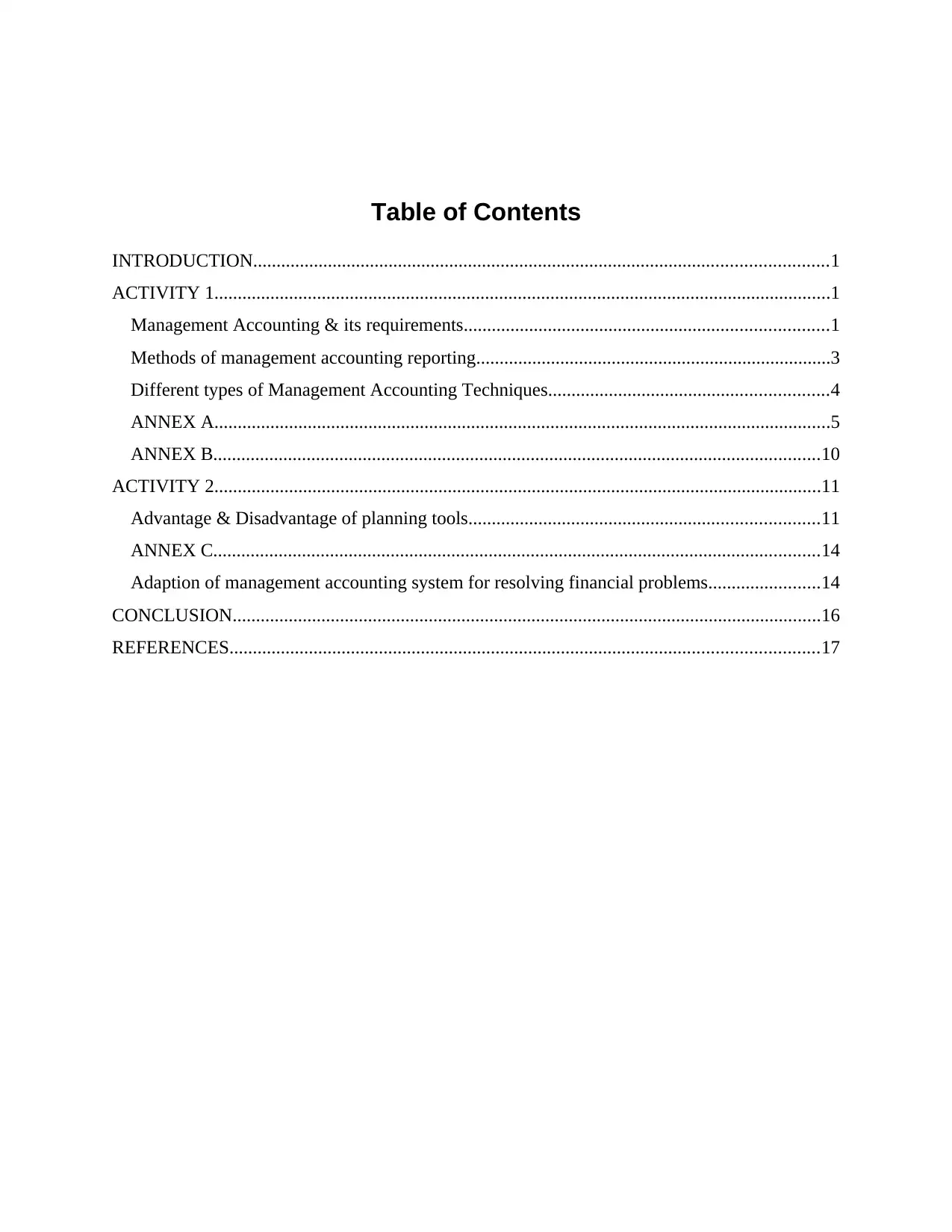
Table of Contents
INTRODUCTION...........................................................................................................................1
ACTIVITY 1....................................................................................................................................1
Management Accounting & its requirements..............................................................................1
Methods of management accounting reporting............................................................................3
Different types of Management Accounting Techniques............................................................4
ANNEX A....................................................................................................................................5
ANNEX B..................................................................................................................................10
ACTIVITY 2..................................................................................................................................11
Advantage & Disadvantage of planning tools...........................................................................11
ANNEX C..................................................................................................................................14
Adaption of management accounting system for resolving financial problems........................14
CONCLUSION..............................................................................................................................16
REFERENCES..............................................................................................................................17
INTRODUCTION...........................................................................................................................1
ACTIVITY 1....................................................................................................................................1
Management Accounting & its requirements..............................................................................1
Methods of management accounting reporting............................................................................3
Different types of Management Accounting Techniques............................................................4
ANNEX A....................................................................................................................................5
ANNEX B..................................................................................................................................10
ACTIVITY 2..................................................................................................................................11
Advantage & Disadvantage of planning tools...........................................................................11
ANNEX C..................................................................................................................................14
Adaption of management accounting system for resolving financial problems........................14
CONCLUSION..............................................................................................................................16
REFERENCES..............................................................................................................................17
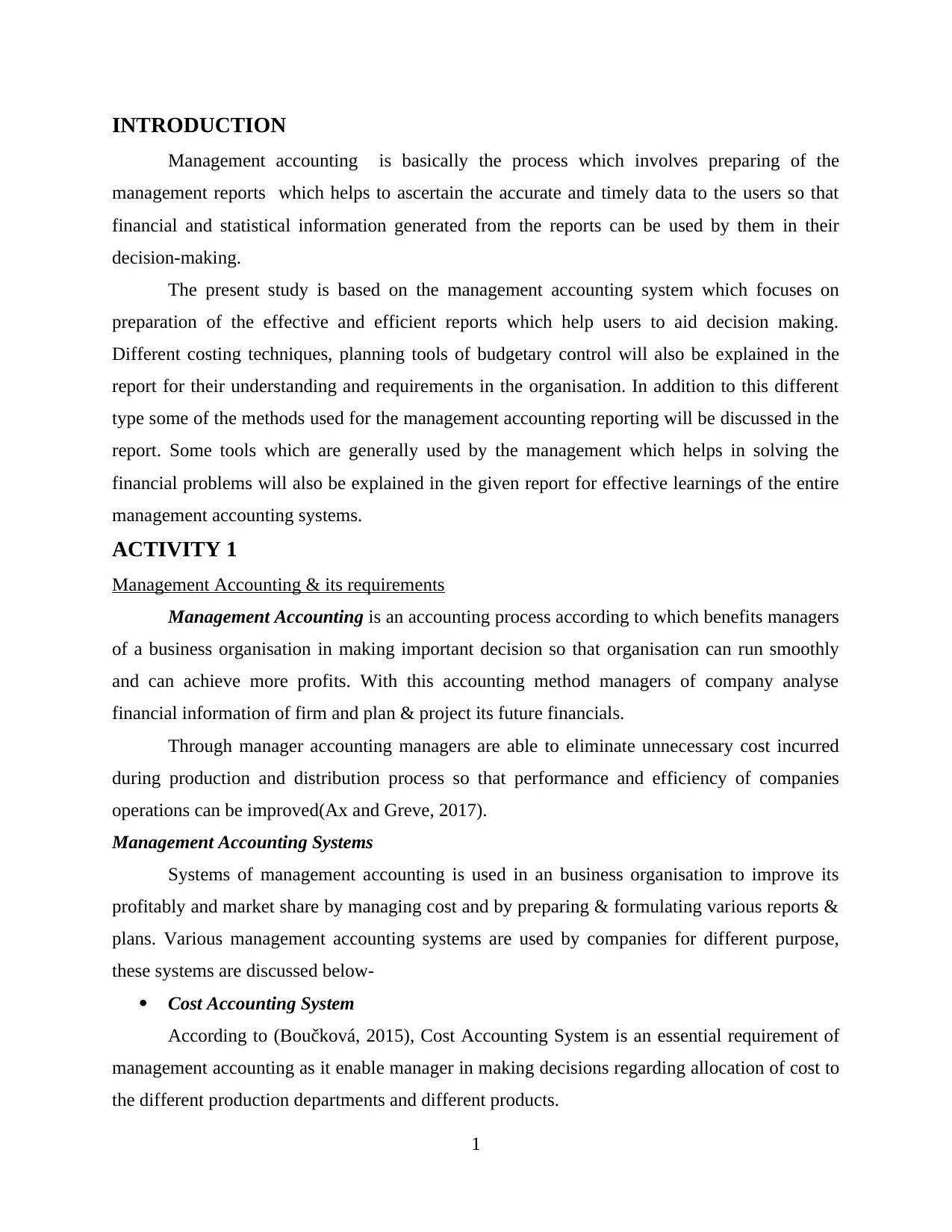
INTRODUCTION
Management accounting is basically the process which involves preparing of the
management reports which helps to ascertain the accurate and timely data to the users so that
financial and statistical information generated from the reports can be used by them in their
decision-making.
The present study is based on the management accounting system which focuses on
preparation of the effective and efficient reports which help users to aid decision making.
Different costing techniques, planning tools of budgetary control will also be explained in the
report for their understanding and requirements in the organisation. In addition to this different
type some of the methods used for the management accounting reporting will be discussed in the
report. Some tools which are generally used by the management which helps in solving the
financial problems will also be explained in the given report for effective learnings of the entire
management accounting systems.
ACTIVITY 1
Management Accounting & its requirements
Management Accounting is an accounting process according to which benefits managers
of a business organisation in making important decision so that organisation can run smoothly
and can achieve more profits. With this accounting method managers of company analyse
financial information of firm and plan & project its future financials.
Through manager accounting managers are able to eliminate unnecessary cost incurred
during production and distribution process so that performance and efficiency of companies
operations can be improved(Ax and Greve, 2017).
Management Accounting Systems
Systems of management accounting is used in an business organisation to improve its
profitably and market share by managing cost and by preparing & formulating various reports &
plans. Various management accounting systems are used by companies for different purpose,
these systems are discussed below-
Cost Accounting System
According to (Boučková, 2015), Cost Accounting System is an essential requirement of
management accounting as it enable manager in making decisions regarding allocation of cost to
the different production departments and different products.
1
Management accounting is basically the process which involves preparing of the
management reports which helps to ascertain the accurate and timely data to the users so that
financial and statistical information generated from the reports can be used by them in their
decision-making.
The present study is based on the management accounting system which focuses on
preparation of the effective and efficient reports which help users to aid decision making.
Different costing techniques, planning tools of budgetary control will also be explained in the
report for their understanding and requirements in the organisation. In addition to this different
type some of the methods used for the management accounting reporting will be discussed in the
report. Some tools which are generally used by the management which helps in solving the
financial problems will also be explained in the given report for effective learnings of the entire
management accounting systems.
ACTIVITY 1
Management Accounting & its requirements
Management Accounting is an accounting process according to which benefits managers
of a business organisation in making important decision so that organisation can run smoothly
and can achieve more profits. With this accounting method managers of company analyse
financial information of firm and plan & project its future financials.
Through manager accounting managers are able to eliminate unnecessary cost incurred
during production and distribution process so that performance and efficiency of companies
operations can be improved(Ax and Greve, 2017).
Management Accounting Systems
Systems of management accounting is used in an business organisation to improve its
profitably and market share by managing cost and by preparing & formulating various reports &
plans. Various management accounting systems are used by companies for different purpose,
these systems are discussed below-
Cost Accounting System
According to (Boučková, 2015), Cost Accounting System is an essential requirement of
management accounting as it enable manager in making decisions regarding allocation of cost to
the different production departments and different products.
1
⊘ This is a preview!⊘
Do you want full access?
Subscribe today to unlock all pages.

Trusted by 1+ million students worldwide
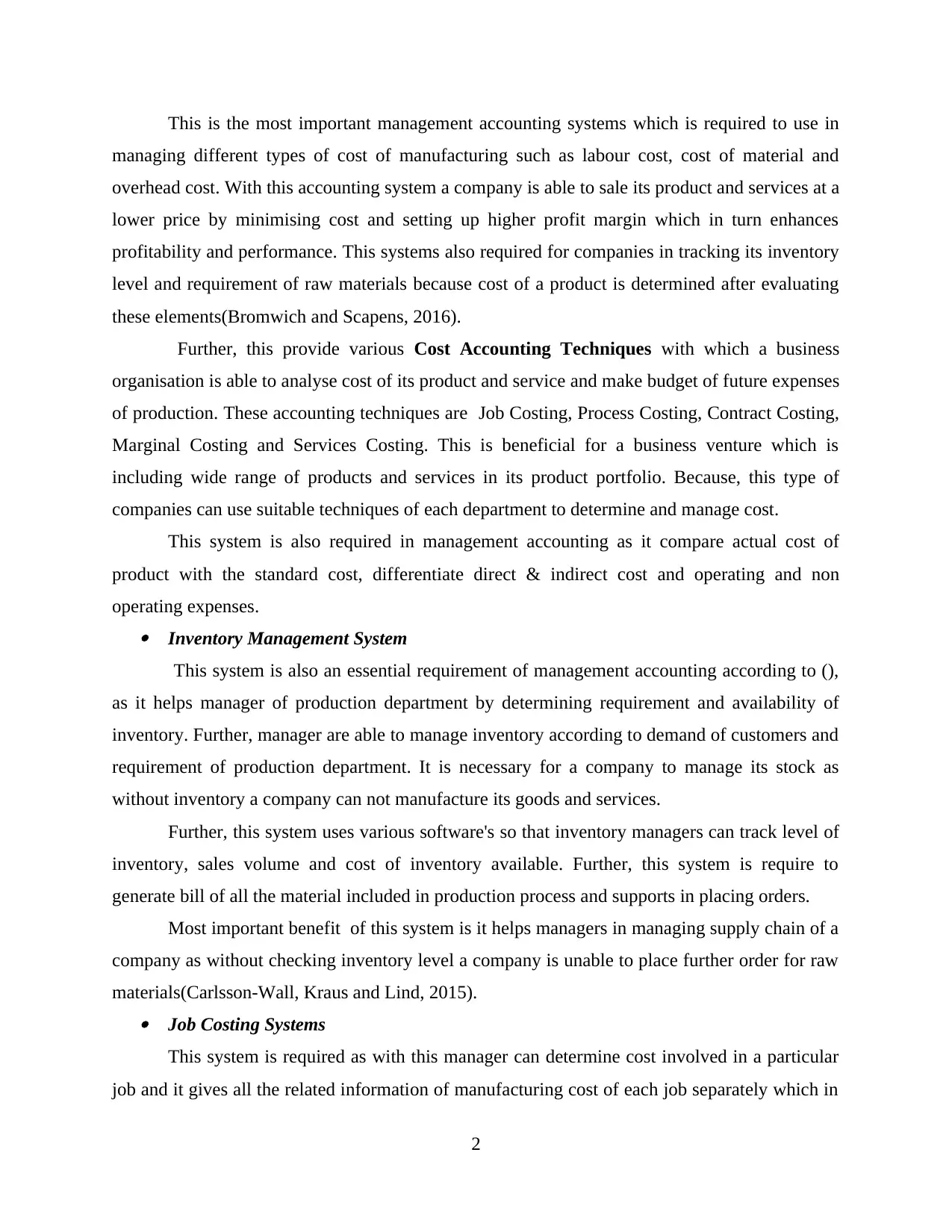
This is the most important management accounting systems which is required to use in
managing different types of cost of manufacturing such as labour cost, cost of material and
overhead cost. With this accounting system a company is able to sale its product and services at a
lower price by minimising cost and setting up higher profit margin which in turn enhances
profitability and performance. This systems also required for companies in tracking its inventory
level and requirement of raw materials because cost of a product is determined after evaluating
these elements(Bromwich and Scapens, 2016).
Further, this provide various Cost Accounting Techniques with which a business
organisation is able to analyse cost of its product and service and make budget of future expenses
of production. These accounting techniques are Job Costing, Process Costing, Contract Costing,
Marginal Costing and Services Costing. This is beneficial for a business venture which is
including wide range of products and services in its product portfolio. Because, this type of
companies can use suitable techniques of each department to determine and manage cost.
This system is also required in management accounting as it compare actual cost of
product with the standard cost, differentiate direct & indirect cost and operating and non
operating expenses. Inventory Management System
This system is also an essential requirement of management accounting according to (),
as it helps manager of production department by determining requirement and availability of
inventory. Further, manager are able to manage inventory according to demand of customers and
requirement of production department. It is necessary for a company to manage its stock as
without inventory a company can not manufacture its goods and services.
Further, this system uses various software's so that inventory managers can track level of
inventory, sales volume and cost of inventory available. Further, this system is require to
generate bill of all the material included in production process and supports in placing orders.
Most important benefit of this system is it helps managers in managing supply chain of a
company as without checking inventory level a company is unable to place further order for raw
materials(Carlsson-Wall, Kraus and Lind, 2015). Job Costing Systems
This system is required as with this manager can determine cost involved in a particular
job and it gives all the related information of manufacturing cost of each job separately which in
2
managing different types of cost of manufacturing such as labour cost, cost of material and
overhead cost. With this accounting system a company is able to sale its product and services at a
lower price by minimising cost and setting up higher profit margin which in turn enhances
profitability and performance. This systems also required for companies in tracking its inventory
level and requirement of raw materials because cost of a product is determined after evaluating
these elements(Bromwich and Scapens, 2016).
Further, this provide various Cost Accounting Techniques with which a business
organisation is able to analyse cost of its product and service and make budget of future expenses
of production. These accounting techniques are Job Costing, Process Costing, Contract Costing,
Marginal Costing and Services Costing. This is beneficial for a business venture which is
including wide range of products and services in its product portfolio. Because, this type of
companies can use suitable techniques of each department to determine and manage cost.
This system is also required in management accounting as it compare actual cost of
product with the standard cost, differentiate direct & indirect cost and operating and non
operating expenses. Inventory Management System
This system is also an essential requirement of management accounting according to (),
as it helps manager of production department by determining requirement and availability of
inventory. Further, manager are able to manage inventory according to demand of customers and
requirement of production department. It is necessary for a company to manage its stock as
without inventory a company can not manufacture its goods and services.
Further, this system uses various software's so that inventory managers can track level of
inventory, sales volume and cost of inventory available. Further, this system is require to
generate bill of all the material included in production process and supports in placing orders.
Most important benefit of this system is it helps managers in managing supply chain of a
company as without checking inventory level a company is unable to place further order for raw
materials(Carlsson-Wall, Kraus and Lind, 2015). Job Costing Systems
This system is required as with this manager can determine cost involved in a particular
job and it gives all the related information of manufacturing cost of each job separately which in
2
Paraphrase This Document
Need a fresh take? Get an instant paraphrase of this document with our AI Paraphraser
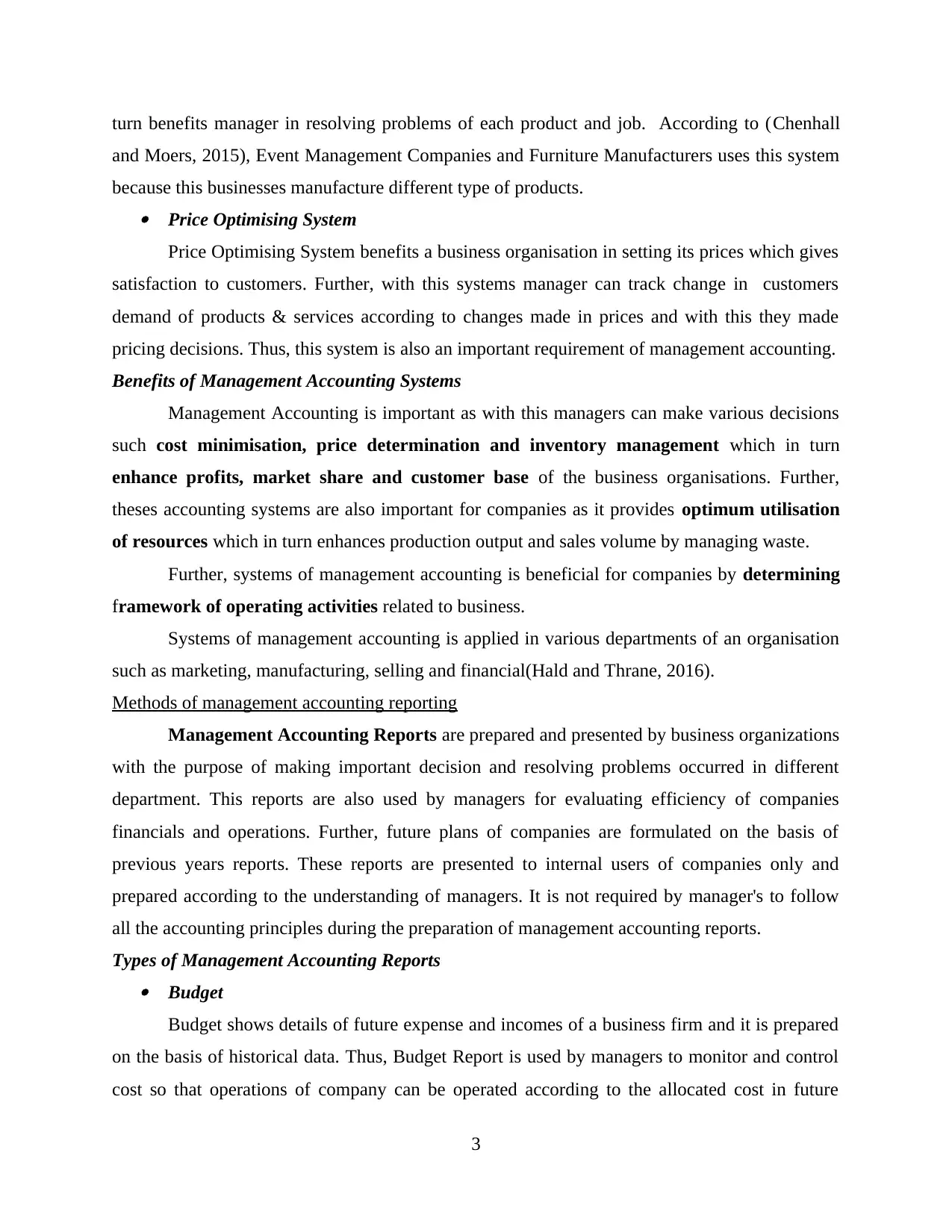
turn benefits manager in resolving problems of each product and job. According to (Chenhall
and Moers, 2015), Event Management Companies and Furniture Manufacturers uses this system
because this businesses manufacture different type of products. Price Optimising System
Price Optimising System benefits a business organisation in setting its prices which gives
satisfaction to customers. Further, with this systems manager can track change in customers
demand of products & services according to changes made in prices and with this they made
pricing decisions. Thus, this system is also an important requirement of management accounting.
Benefits of Management Accounting Systems
Management Accounting is important as with this managers can make various decisions
such cost minimisation, price determination and inventory management which in turn
enhance profits, market share and customer base of the business organisations. Further,
theses accounting systems are also important for companies as it provides optimum utilisation
of resources which in turn enhances production output and sales volume by managing waste.
Further, systems of management accounting is beneficial for companies by determining
framework of operating activities related to business.
Systems of management accounting is applied in various departments of an organisation
such as marketing, manufacturing, selling and financial(Hald and Thrane, 2016).
Methods of management accounting reporting
Management Accounting Reports are prepared and presented by business organizations
with the purpose of making important decision and resolving problems occurred in different
department. This reports are also used by managers for evaluating efficiency of companies
financials and operations. Further, future plans of companies are formulated on the basis of
previous years reports. These reports are presented to internal users of companies only and
prepared according to the understanding of managers. It is not required by manager's to follow
all the accounting principles during the preparation of management accounting reports.
Types of Management Accounting Reports Budget
Budget shows details of future expense and incomes of a business firm and it is prepared
on the basis of historical data. Thus, Budget Report is used by managers to monitor and control
cost so that operations of company can be operated according to the allocated cost in future
3
and Moers, 2015), Event Management Companies and Furniture Manufacturers uses this system
because this businesses manufacture different type of products. Price Optimising System
Price Optimising System benefits a business organisation in setting its prices which gives
satisfaction to customers. Further, with this systems manager can track change in customers
demand of products & services according to changes made in prices and with this they made
pricing decisions. Thus, this system is also an important requirement of management accounting.
Benefits of Management Accounting Systems
Management Accounting is important as with this managers can make various decisions
such cost minimisation, price determination and inventory management which in turn
enhance profits, market share and customer base of the business organisations. Further,
theses accounting systems are also important for companies as it provides optimum utilisation
of resources which in turn enhances production output and sales volume by managing waste.
Further, systems of management accounting is beneficial for companies by determining
framework of operating activities related to business.
Systems of management accounting is applied in various departments of an organisation
such as marketing, manufacturing, selling and financial(Hald and Thrane, 2016).
Methods of management accounting reporting
Management Accounting Reports are prepared and presented by business organizations
with the purpose of making important decision and resolving problems occurred in different
department. This reports are also used by managers for evaluating efficiency of companies
financials and operations. Further, future plans of companies are formulated on the basis of
previous years reports. These reports are presented to internal users of companies only and
prepared according to the understanding of managers. It is not required by manager's to follow
all the accounting principles during the preparation of management accounting reports.
Types of Management Accounting Reports Budget
Budget shows details of future expense and incomes of a business firm and it is prepared
on the basis of historical data. Thus, Budget Report is used by managers to monitor and control
cost so that operations of company can be operated according to the allocated cost in future
3
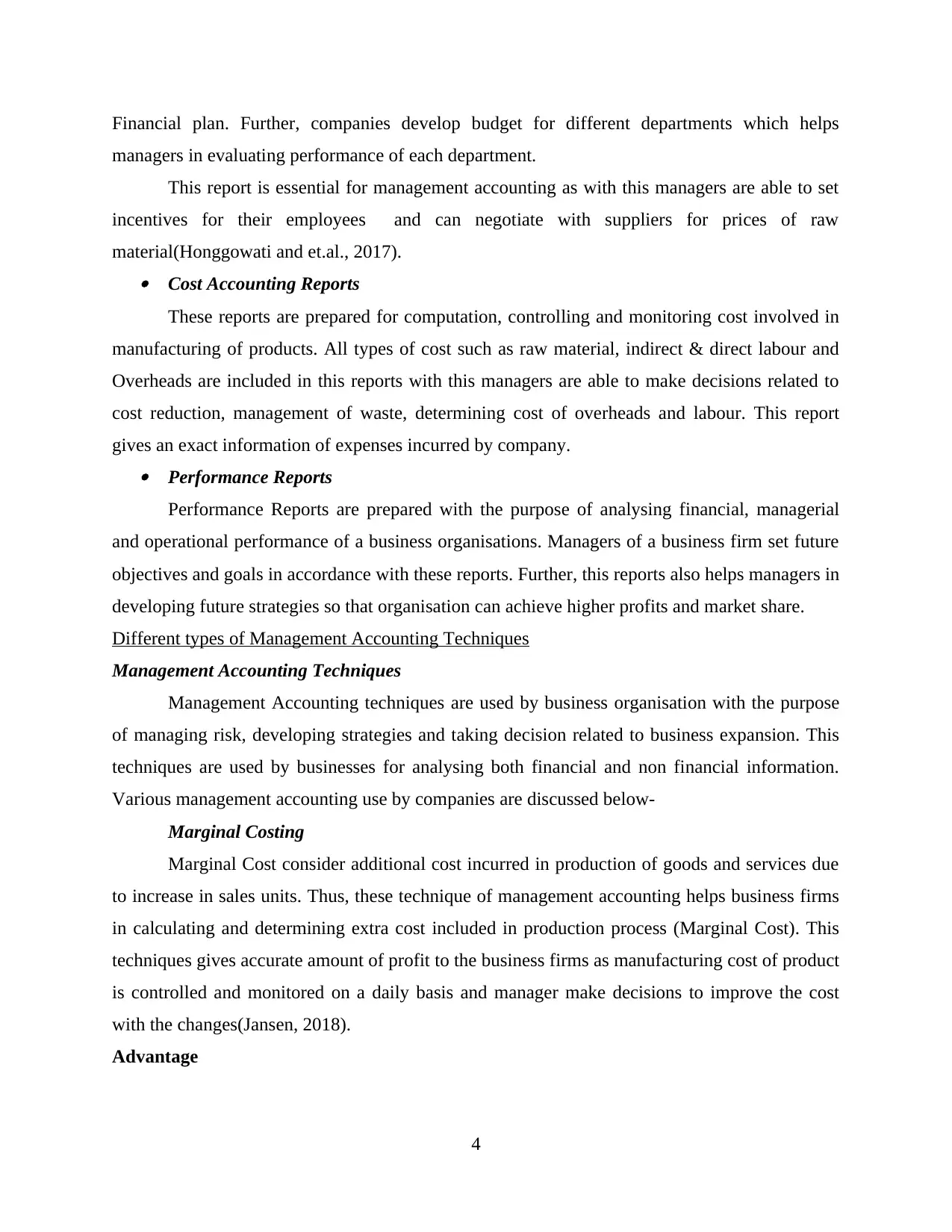
Financial plan. Further, companies develop budget for different departments which helps
managers in evaluating performance of each department.
This report is essential for management accounting as with this managers are able to set
incentives for their employees and can negotiate with suppliers for prices of raw
material(Honggowati and et.al., 2017). Cost Accounting Reports
These reports are prepared for computation, controlling and monitoring cost involved in
manufacturing of products. All types of cost such as raw material, indirect & direct labour and
Overheads are included in this reports with this managers are able to make decisions related to
cost reduction, management of waste, determining cost of overheads and labour. This report
gives an exact information of expenses incurred by company. Performance Reports
Performance Reports are prepared with the purpose of analysing financial, managerial
and operational performance of a business organisations. Managers of a business firm set future
objectives and goals in accordance with these reports. Further, this reports also helps managers in
developing future strategies so that organisation can achieve higher profits and market share.
Different types of Management Accounting Techniques
Management Accounting Techniques
Management Accounting techniques are used by business organisation with the purpose
of managing risk, developing strategies and taking decision related to business expansion. This
techniques are used by businesses for analysing both financial and non financial information.
Various management accounting use by companies are discussed below-
Marginal Costing
Marginal Cost consider additional cost incurred in production of goods and services due
to increase in sales units. Thus, these technique of management accounting helps business firms
in calculating and determining extra cost included in production process (Marginal Cost). This
techniques gives accurate amount of profit to the business firms as manufacturing cost of product
is controlled and monitored on a daily basis and manager make decisions to improve the cost
with the changes(Jansen, 2018).
Advantage
4
managers in evaluating performance of each department.
This report is essential for management accounting as with this managers are able to set
incentives for their employees and can negotiate with suppliers for prices of raw
material(Honggowati and et.al., 2017). Cost Accounting Reports
These reports are prepared for computation, controlling and monitoring cost involved in
manufacturing of products. All types of cost such as raw material, indirect & direct labour and
Overheads are included in this reports with this managers are able to make decisions related to
cost reduction, management of waste, determining cost of overheads and labour. This report
gives an exact information of expenses incurred by company. Performance Reports
Performance Reports are prepared with the purpose of analysing financial, managerial
and operational performance of a business organisations. Managers of a business firm set future
objectives and goals in accordance with these reports. Further, this reports also helps managers in
developing future strategies so that organisation can achieve higher profits and market share.
Different types of Management Accounting Techniques
Management Accounting Techniques
Management Accounting techniques are used by business organisation with the purpose
of managing risk, developing strategies and taking decision related to business expansion. This
techniques are used by businesses for analysing both financial and non financial information.
Various management accounting use by companies are discussed below-
Marginal Costing
Marginal Cost consider additional cost incurred in production of goods and services due
to increase in sales units. Thus, these technique of management accounting helps business firms
in calculating and determining extra cost included in production process (Marginal Cost). This
techniques gives accurate amount of profit to the business firms as manufacturing cost of product
is controlled and monitored on a daily basis and manager make decisions to improve the cost
with the changes(Jansen, 2018).
Advantage
4
⊘ This is a preview!⊘
Do you want full access?
Subscribe today to unlock all pages.

Trusted by 1+ million students worldwide
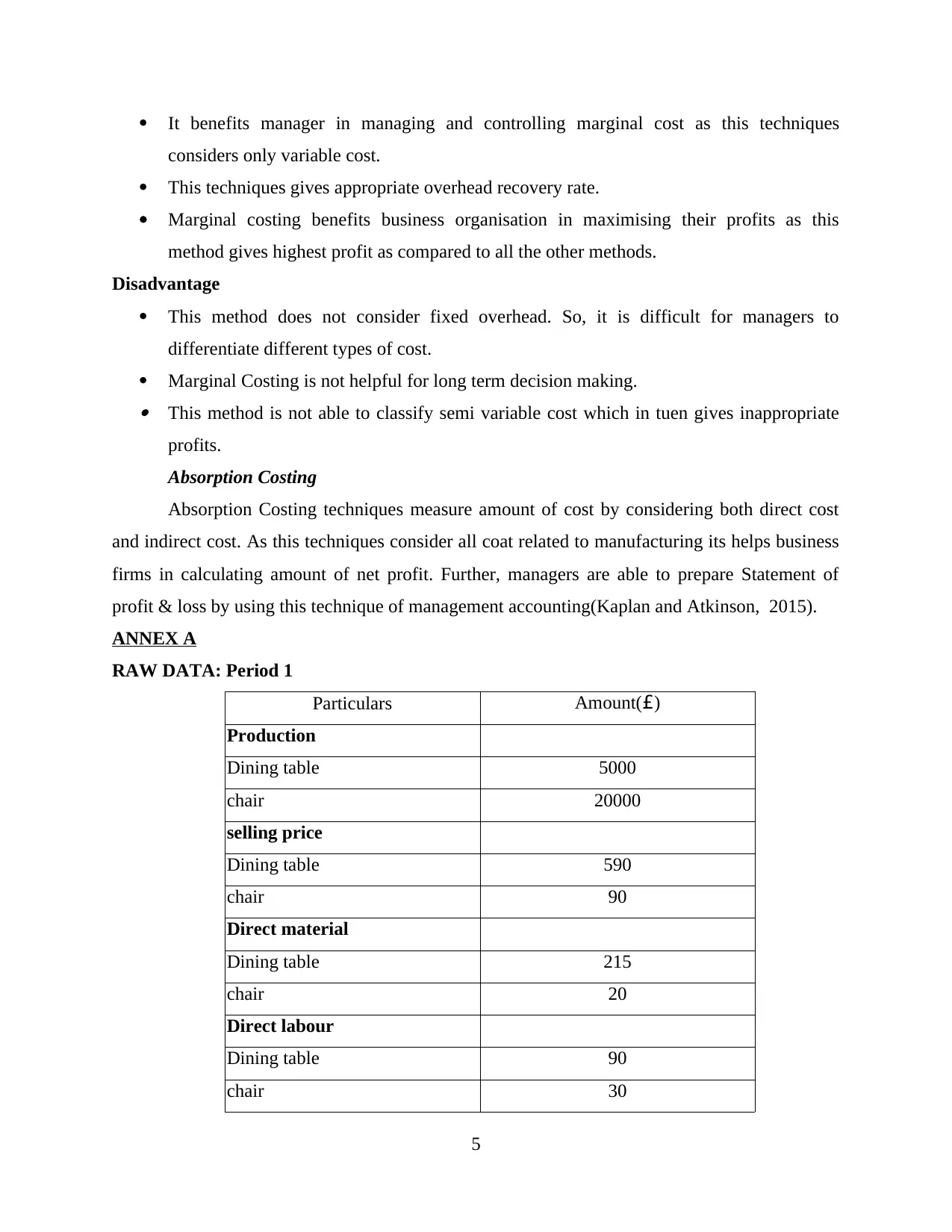
It benefits manager in managing and controlling marginal cost as this techniques
considers only variable cost.
This techniques gives appropriate overhead recovery rate.
Marginal costing benefits business organisation in maximising their profits as this
method gives highest profit as compared to all the other methods.
Disadvantage
This method does not consider fixed overhead. So, it is difficult for managers to
differentiate different types of cost.
Marginal Costing is not helpful for long term decision making. This method is not able to classify semi variable cost which in tuen gives inappropriate
profits.
Absorption Costing
Absorption Costing techniques measure amount of cost by considering both direct cost
and indirect cost. As this techniques consider all coat related to manufacturing its helps business
firms in calculating amount of net profit. Further, managers are able to prepare Statement of
profit & loss by using this technique of management accounting(Kaplan and Atkinson, 2015).
ANNEX A
RAW DATA: Period 1
Particulars Amount(£)
Production
Dining table 5000
chair 20000
selling price
Dining table 590
chair 90
Direct material
Dining table 215
chair 20
Direct labour
Dining table 90
chair 30
5
considers only variable cost.
This techniques gives appropriate overhead recovery rate.
Marginal costing benefits business organisation in maximising their profits as this
method gives highest profit as compared to all the other methods.
Disadvantage
This method does not consider fixed overhead. So, it is difficult for managers to
differentiate different types of cost.
Marginal Costing is not helpful for long term decision making. This method is not able to classify semi variable cost which in tuen gives inappropriate
profits.
Absorption Costing
Absorption Costing techniques measure amount of cost by considering both direct cost
and indirect cost. As this techniques consider all coat related to manufacturing its helps business
firms in calculating amount of net profit. Further, managers are able to prepare Statement of
profit & loss by using this technique of management accounting(Kaplan and Atkinson, 2015).
ANNEX A
RAW DATA: Period 1
Particulars Amount(£)
Production
Dining table 5000
chair 20000
selling price
Dining table 590
chair 90
Direct material
Dining table 215
chair 20
Direct labour
Dining table 90
chair 30
5
Paraphrase This Document
Need a fresh take? Get an instant paraphrase of this document with our AI Paraphraser
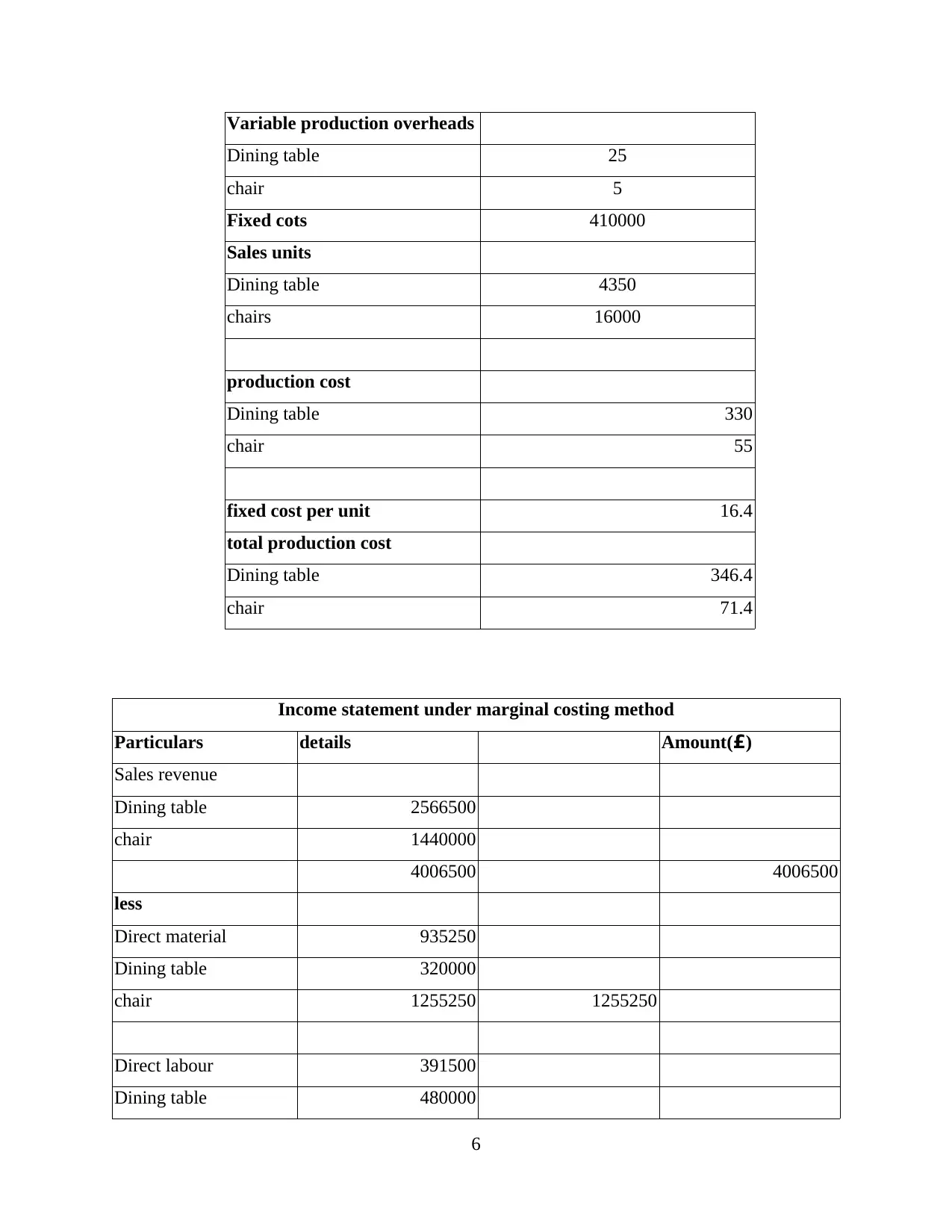
Variable production overheads
Dining table 25
chair 5
Fixed cots 410000
Sales units
Dining table 4350
chairs 16000
production cost
Dining table 330
chair 55
fixed cost per unit 16.4
total production cost
Dining table 346.4
chair 71.4
Income statement under marginal costing method
Particulars details Amount(£)
Sales revenue
Dining table 2566500
chair 1440000
4006500 4006500
less
Direct material 935250
Dining table 320000
chair 1255250 1255250
Direct labour 391500
Dining table 480000
6
Dining table 25
chair 5
Fixed cots 410000
Sales units
Dining table 4350
chairs 16000
production cost
Dining table 330
chair 55
fixed cost per unit 16.4
total production cost
Dining table 346.4
chair 71.4
Income statement under marginal costing method
Particulars details Amount(£)
Sales revenue
Dining table 2566500
chair 1440000
4006500 4006500
less
Direct material 935250
Dining table 320000
chair 1255250 1255250
Direct labour 391500
Dining table 480000
6
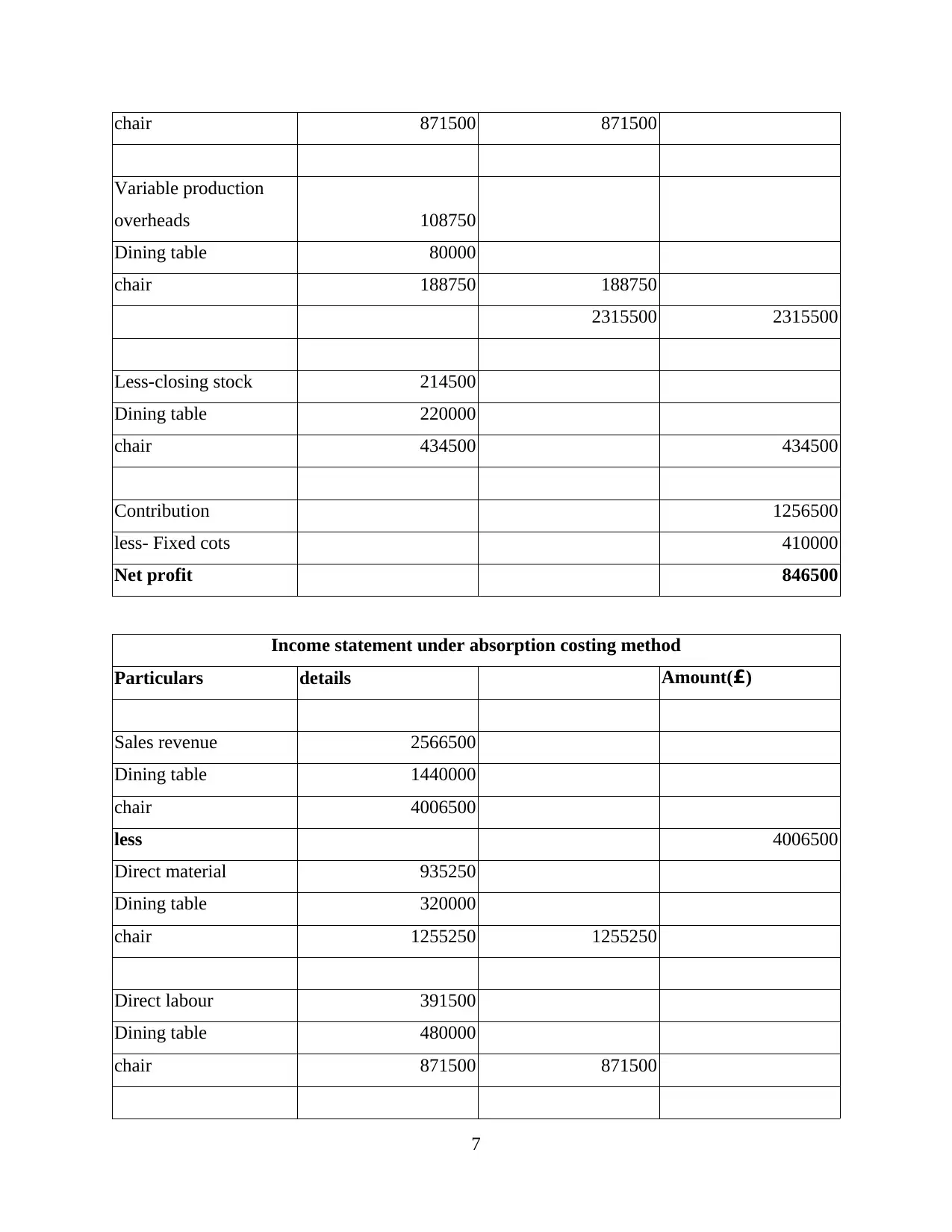
chair 871500 871500
Variable production
overheads 108750
Dining table 80000
chair 188750 188750
2315500 2315500
Less-closing stock 214500
Dining table 220000
chair 434500 434500
Contribution 1256500
less- Fixed cots 410000
Net profit 846500
Income statement under absorption costing method
Particulars details Amount(£)
Sales revenue 2566500
Dining table 1440000
chair 4006500
less 4006500
Direct material 935250
Dining table 320000
chair 1255250 1255250
Direct labour 391500
Dining table 480000
chair 871500 871500
7
Variable production
overheads 108750
Dining table 80000
chair 188750 188750
2315500 2315500
Less-closing stock 214500
Dining table 220000
chair 434500 434500
Contribution 1256500
less- Fixed cots 410000
Net profit 846500
Income statement under absorption costing method
Particulars details Amount(£)
Sales revenue 2566500
Dining table 1440000
chair 4006500
less 4006500
Direct material 935250
Dining table 320000
chair 1255250 1255250
Direct labour 391500
Dining table 480000
chair 871500 871500
7
⊘ This is a preview!⊘
Do you want full access?
Subscribe today to unlock all pages.

Trusted by 1+ million students worldwide
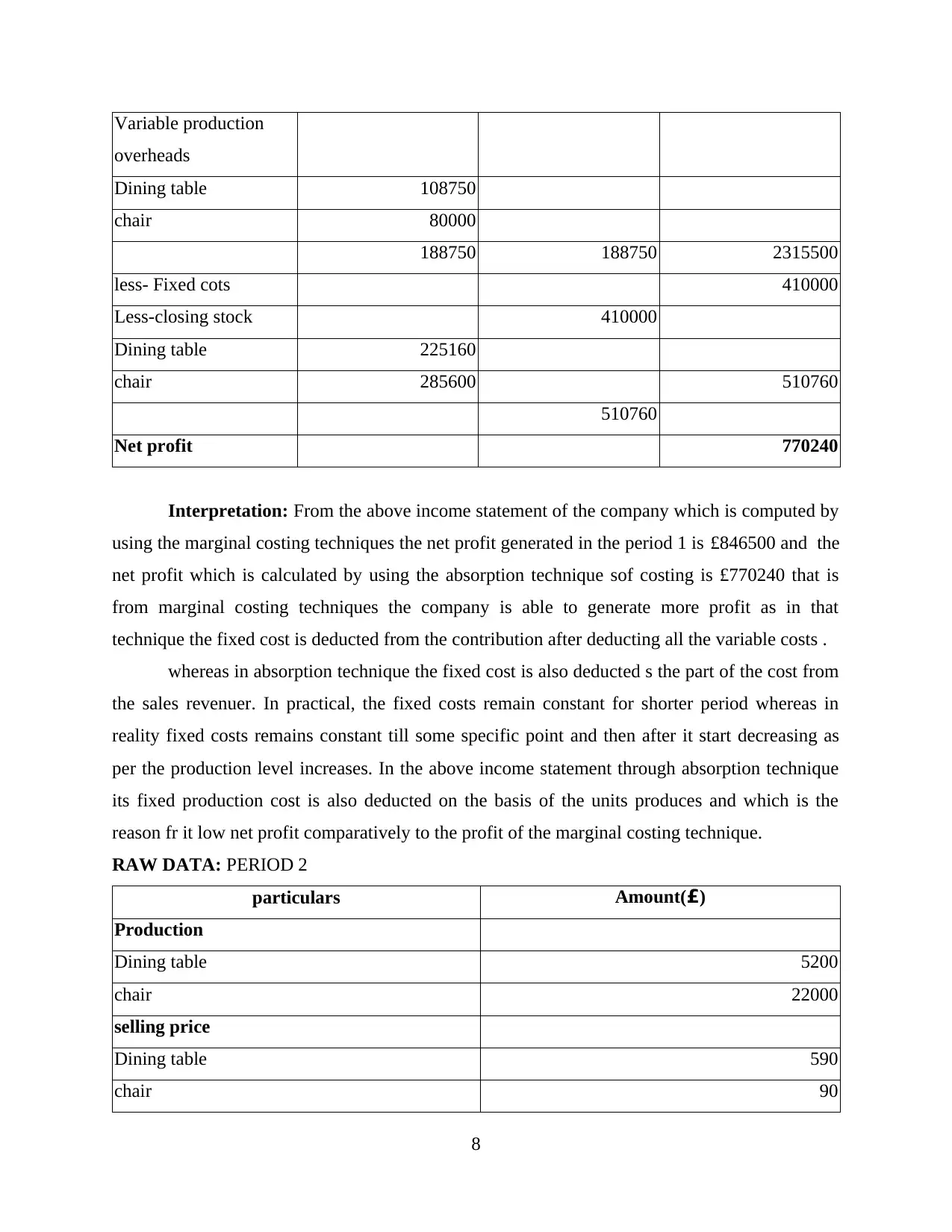
Variable production
overheads
Dining table 108750
chair 80000
188750 188750 2315500
less- Fixed cots 410000
Less-closing stock 410000
Dining table 225160
chair 285600 510760
510760
Net profit 770240
Interpretation: From the above income statement of the company which is computed by
using the marginal costing techniques the net profit generated in the period 1 is £846500 and the
net profit which is calculated by using the absorption technique sof costing is £770240 that is
from marginal costing techniques the company is able to generate more profit as in that
technique the fixed cost is deducted from the contribution after deducting all the variable costs .
whereas in absorption technique the fixed cost is also deducted s the part of the cost from
the sales revenuer. In practical, the fixed costs remain constant for shorter period whereas in
reality fixed costs remains constant till some specific point and then after it start decreasing as
per the production level increases. In the above income statement through absorption technique
its fixed production cost is also deducted on the basis of the units produces and which is the
reason fr it low net profit comparatively to the profit of the marginal costing technique.
RAW DATA: PERIOD 2
particulars Amount(£)
Production
Dining table 5200
chair 22000
selling price
Dining table 590
chair 90
8
overheads
Dining table 108750
chair 80000
188750 188750 2315500
less- Fixed cots 410000
Less-closing stock 410000
Dining table 225160
chair 285600 510760
510760
Net profit 770240
Interpretation: From the above income statement of the company which is computed by
using the marginal costing techniques the net profit generated in the period 1 is £846500 and the
net profit which is calculated by using the absorption technique sof costing is £770240 that is
from marginal costing techniques the company is able to generate more profit as in that
technique the fixed cost is deducted from the contribution after deducting all the variable costs .
whereas in absorption technique the fixed cost is also deducted s the part of the cost from
the sales revenuer. In practical, the fixed costs remain constant for shorter period whereas in
reality fixed costs remains constant till some specific point and then after it start decreasing as
per the production level increases. In the above income statement through absorption technique
its fixed production cost is also deducted on the basis of the units produces and which is the
reason fr it low net profit comparatively to the profit of the marginal costing technique.
RAW DATA: PERIOD 2
particulars Amount(£)
Production
Dining table 5200
chair 22000
selling price
Dining table 590
chair 90
8
Paraphrase This Document
Need a fresh take? Get an instant paraphrase of this document with our AI Paraphraser
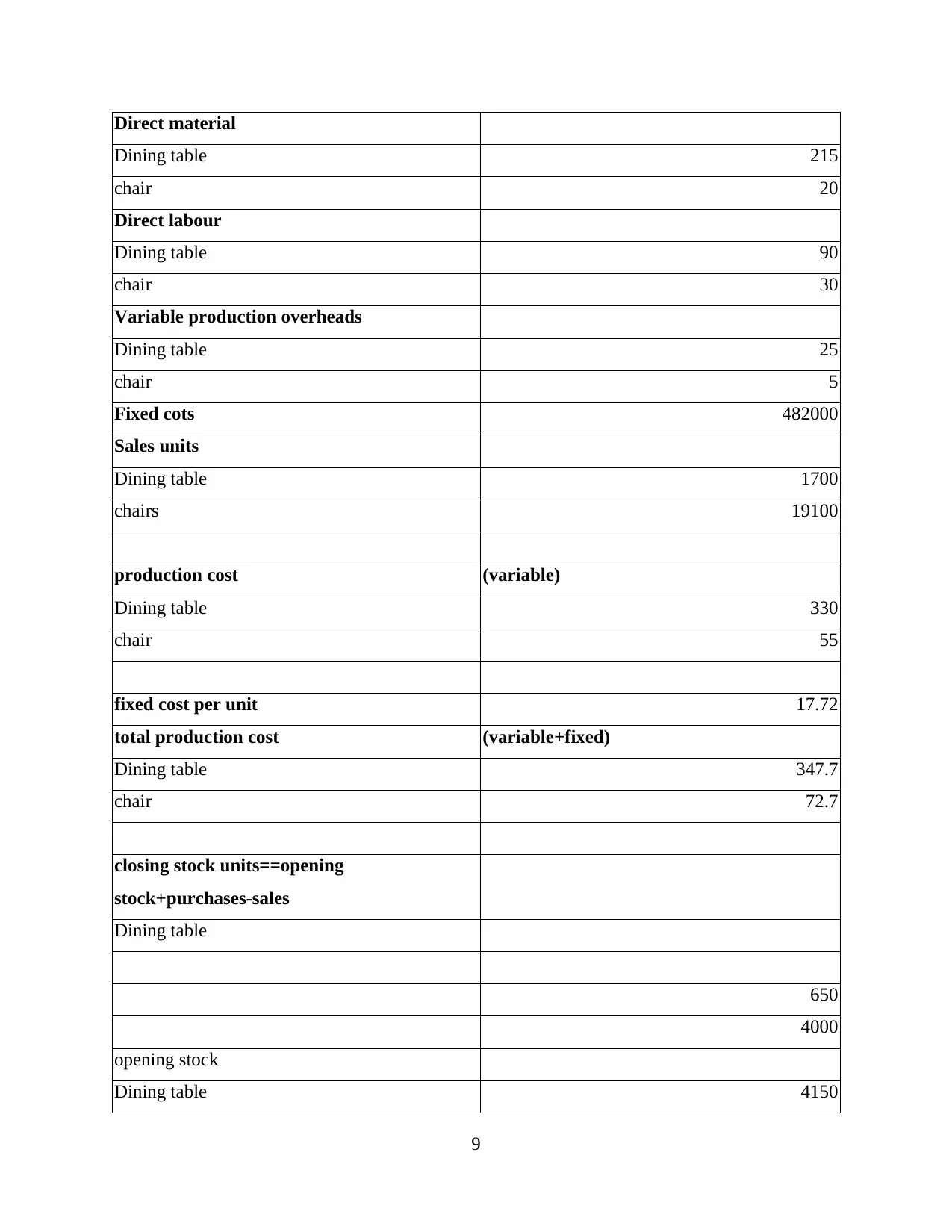
Direct material
Dining table 215
chair 20
Direct labour
Dining table 90
chair 30
Variable production overheads
Dining table 25
chair 5
Fixed cots 482000
Sales units
Dining table 1700
chairs 19100
production cost (variable)
Dining table 330
chair 55
fixed cost per unit 17.72
total production cost (variable+fixed)
Dining table 347.7
chair 72.7
closing stock units==opening
stock+purchases-sales
Dining table
650
4000
opening stock
Dining table 4150
9
Dining table 215
chair 20
Direct labour
Dining table 90
chair 30
Variable production overheads
Dining table 25
chair 5
Fixed cots 482000
Sales units
Dining table 1700
chairs 19100
production cost (variable)
Dining table 330
chair 55
fixed cost per unit 17.72
total production cost (variable+fixed)
Dining table 347.7
chair 72.7
closing stock units==opening
stock+purchases-sales
Dining table
650
4000
opening stock
Dining table 4150
9
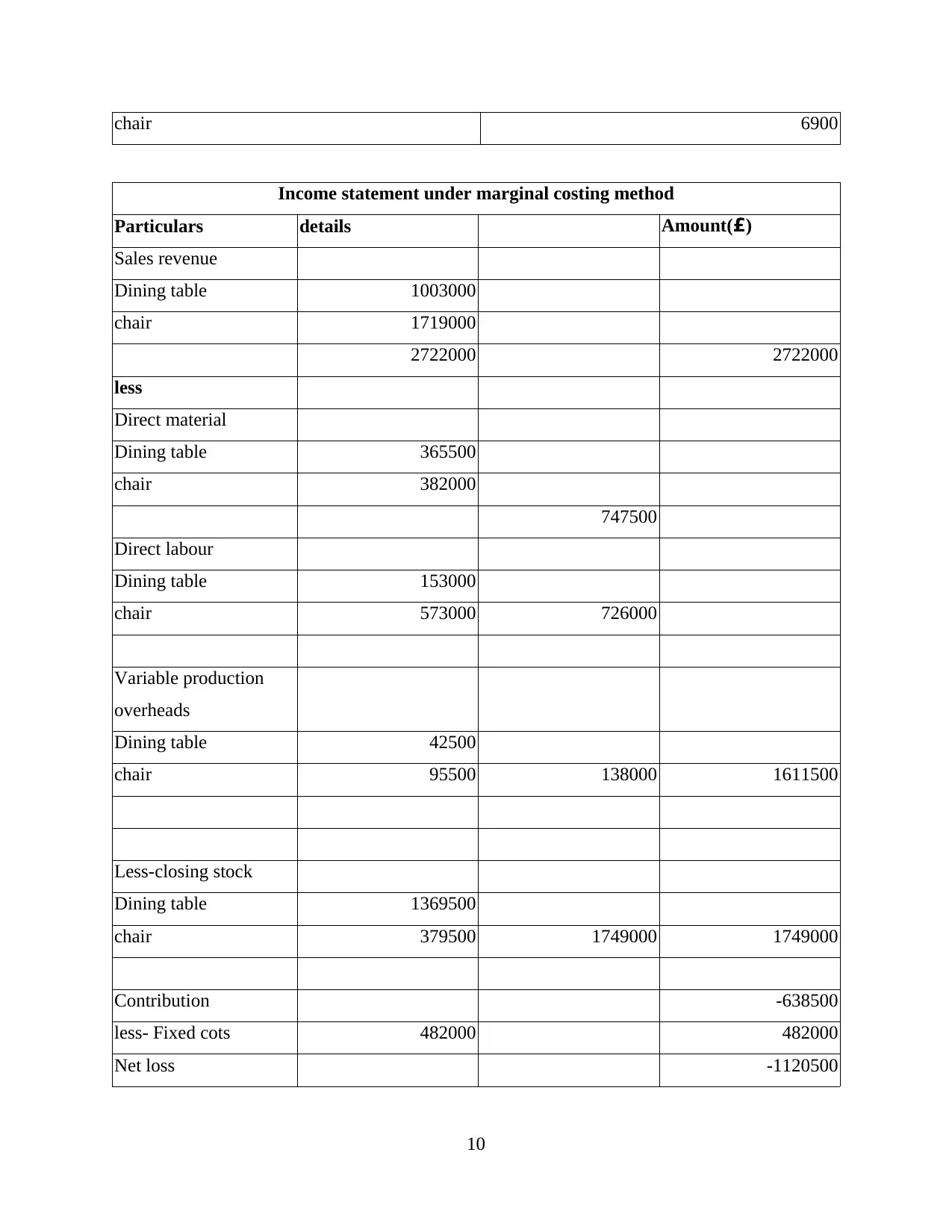
chair 6900
Income statement under marginal costing method
Particulars details Amount(£)
Sales revenue
Dining table 1003000
chair 1719000
2722000 2722000
less
Direct material
Dining table 365500
chair 382000
747500
Direct labour
Dining table 153000
chair 573000 726000
Variable production
overheads
Dining table 42500
chair 95500 138000 1611500
Less-closing stock
Dining table 1369500
chair 379500 1749000 1749000
Contribution -638500
less- Fixed cots 482000 482000
Net loss -1120500
10
Income statement under marginal costing method
Particulars details Amount(£)
Sales revenue
Dining table 1003000
chair 1719000
2722000 2722000
less
Direct material
Dining table 365500
chair 382000
747500
Direct labour
Dining table 153000
chair 573000 726000
Variable production
overheads
Dining table 42500
chair 95500 138000 1611500
Less-closing stock
Dining table 1369500
chair 379500 1749000 1749000
Contribution -638500
less- Fixed cots 482000 482000
Net loss -1120500
10
⊘ This is a preview!⊘
Do you want full access?
Subscribe today to unlock all pages.

Trusted by 1+ million students worldwide
1 out of 21
Related Documents
Your All-in-One AI-Powered Toolkit for Academic Success.
+13062052269
info@desklib.com
Available 24*7 on WhatsApp / Email
![[object Object]](/_next/static/media/star-bottom.7253800d.svg)
Unlock your academic potential
Copyright © 2020–2025 A2Z Services. All Rights Reserved. Developed and managed by ZUCOL.





